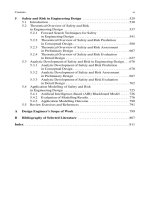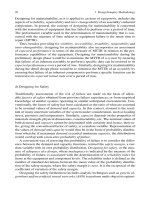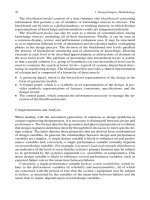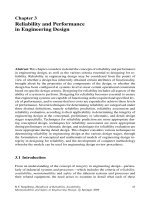Handbook of Reliability, Availability, Maintainability and Safety in Engineering Design - Part 46 ppsx
Bạn đang xem bản rút gọn của tài liệu. Xem và tải ngay bản đầy đủ của tài liệu tại đây (138.05 KB, 10 trang )
4.3 Analytic Development of Availability and Maintainability in Engineering Design 433
Fig. 4.16 Flowchart of the
Monte Carlo simulation pro-
cedure (La w et al. 1991)
H times
a) Generate samples of
x
1
and x
2
N times
M times
b) Generate samples of
ε
1
(x
1
)
d) Generate samples of
ε
2
(x
2
,y)
f) Obtain c.d.f or p.d.f
of z
c) Calculate output of
simulation model I
y=F
1
(x
1
)+ε
1
(x
1
)
c) Calculate output of
simulation model II
z=F
2
(x
2
,y)+ε
2
(x
2
,y)
The Monte Carlo simulation approach generates statistical estimates of the sys-
tem output based on the given distributions of the inputs and error models. This
gives more information than does the extreme condition approach, by which only
the best and worst performance are estimated. Because the statistical approach is
based on Monte Carlo simulation, it often requires a large number of simulations.
More effective sampling techniques such as the Latin hypercube and fractional fac-
torial design can be used to reduce the amount of simulations (Hicks 1993).
The Monte Carlo simulation procedure is as follows (Law et al. 1991):
i) Generate H samples of x
1
and x
2
as simulation inputs based on distribution
functions.
ii) For the given x
1
, calculate the distribution parameters of the internal uncer-
tainty
ε
1
(x
1
) for simulation model I, and generate N samples of the internal
uncertainty
ε
1
for simulation model I based on the distribution function.
iii) Evaluate the corresponding output y= F
1
(x
1
)+
ε
1
(x
1
) for simulation model I.
iv) For each y, calculate the distribution parameters of the internal uncertainty
ε
2
(x
2
y) of simulation model II, and generate M sam ples of the internal un cer-
tainty
ε
2
based on the distribution function.
v) Evaluatethe correspondingoutputz = F
2
(x
2
)+
ε
2
(x
2
) for simulation model II.
vi) Calculate the mea n value
μ
z
,thestandard deviation
σ
z
or the c.d.f. and p.d.f.
of z based on H ×M×N samples of z.
434 4 Availability and Maintainability in Engineering Design
d) Mitigating the Effect of Uncertainty
To assist designers to make reliable design decisions under uncertainties, the p ro-
posed techniques of propagating the effect of uncertainties is integrated with the
multidisciplinary optimisation approach based on the principles of rob ust design,
i.e. by extending the quality engineering concept to the mitigation of the effects of
both external and internal uncertainties. From the viewpoint of robust design, the
goal is to make the system (or product) least sensitive to the potential variations
without eliminating the sources of uncertainty (Taguchi 1993).
The same concept is used here to reduce the impact of both external and internal
uncertainties associated with the simulation programs. The robust optimisation ob-
jectives are achieved by simultaneously optimising mean performance and reducing
performance variation, subject to the constraints brought about by their deviations.
Taguchi’s robust design h as been used in the past f or mitigating th e effect of param-
eter uncertainty, which is similar to the external uncertainty considered here.
This concept is extend ed to mitigate the effect of model structure uncertainty
(internal uncertainty). For the extreme condition approach, the robust design model
can be formulated as:
Given: (4.155)
Parameter and model uncertainties (ranges)
Find:
Robust design decisions (x)
Subject to:
System constraints: g
worst
(x) ≤ 0
Objectives:
i) Optimise the mean of system attributes: a(x)
ii) Minimise the deviation of system attributes: Δa(x) .
In the above model, g
worst
(x) is the maximum constraint function estimated by the
worst case of constraint function g(x),anda is the objective vector. Both g(x)
and a(x) are the subsets of system output vector z. The mean and deviation of the
system outputs can be obtained by the extreme condition approach as introduced
earlier. This constitutes the necessary multiple objectives in robust design (i.e. both
the mean and the deviation of the system are expected to be minimised with the as-
sumption that optimising the mean of a system attribute can always be transformed
into a minimisation problem ). The g eneral form of the objective can be expressed
as:
min[ax,Δa(x)] (4.156)
Many existing appro aches can be used to solve this multi-objective robust optimi-
sation problem. In the above model, the worst-case analysis is used to formulate the
constraints. The worst-case analysis assumes that all fluctuations may occur simul-
taneously in the worst possible combination (Parkinson et al. 1993). The effect of
4.3 Analytic Development of Availability and Maintainability in Engineering Design 435
variations on a function is estimated using a first-order Taylor’s series as follows:
Δg(x)=
∑
f
∂
g(x)Δ(x)
∂
x
1
(4.157)
where Δg(x) represents the variation transmitted to constraint g(x) for a worst-case
analysis.
The design feasibility expressed in Eq. (4.155) can be formulated by increasing
the value of the mean g(x) by the functional variation Δg (x):
g
worst
(x)=Δg(x)+
∑
f
∂
g(x)Δx
∂
x
1
(4.158)
For the statistical approach to estimate the performance distribution, the robust
model can be formulated as:
Given: (4.159)
Parameter and model uncertainties (distributions)
Find:
Robust design decisions x
Subject to:
System constraints: P[g(x) ≤ 0 ] ≥P limit
Objectives:
i) Optimise the mean of system attributes a(x):
μ
a
(x)
ii) Minimise the standard deviation of system attributes a(x):
σ
a
(x) .
μ
a
(x) and
σ
a
(x) are the estimates of the mean and variance of the system outputs
respectively. The constraints in the above model are expressed by the probab ilistic
formulation. P[g(x) ≤ 0] is the probability of constraint satisfaction, and it should
be greater than or equal to the defined probability limit P
limit
.
Because it is computationally expensive to evaluate the probability of constraint
satisfaction, alternativeform ulations—for example, the moment matchingmethod—
are used in practice to evaluate the constraints. With the moment matching method,
g(x) is assumed to follow a normal distribution (Parkinson et al. 1993).
The constraint in Eq. (4.159) is (Parkinson et al. 1993):
μ
a
(x)+k
σ
a
(x) ≤ 0 (4.160)
where k is the constant for the probability of constraint satisfaction.
For example, k = 1 stands for the probability ≈0.8413 and k = 2 stands for prob-
ability ≈0.9772.
Based on the previous considerations, the strategy that integrates the propagation
and mitigation of the effect of uncertainties is summarised in Fig. 4 .17. Module A is
the uncertainty quantification module that represents the first stage in the integrated
methodology. Module B is the propagation module. In this module, either the ex-
treme condition approach or the statistical approach is used to identify the range or
to estimate the population parameters of system performance under the influence of
436 4 Availability and Maintainability in Engineering Design
A.
Uncertainty
quantification
module
B.
Propagation
module
Range
[x
1min
, x
1max
]
[x
2min
, x
2max
]
[z
min
, z
max
]
or
(μ
z
, σ
z
)
External uncertainties
range Δx
1
and Δx
2
or c.d.f of x
1
and x
2
Internal uncertainties
ε
1
(x
1
) and ε
2
(x
2
,y)
[x
1min
, x
1max
]
[x
2min
, x
2max
]
ε
1
(x
1
), ε
2
(x
2
,y)
or c.d.f of x
1
and x
2
ε
1
(x
1
), ε
2
(x
2
,y)
optimization
simulation
[z
min
, z
max
]
(μ
z
, σ
z
)
Fig. 4.17 Propagation and mitigation strategy of the effect of uncertainties (Parkinson et al. 1993)
both internal and external uncertainties. The performance ranges or estimated pop-
ulation parameters a re then used to mitigate the effect of uncertainties. The basis
for controlling the effect of uncer tainties is the robust design approach formulated
in Eqs. (4.155) and (4.159). The process to manage the effect of uncertainty is it-
erative and involves repeated uncertainty analysis until a robust optimal solution is
obtained.
4.3.2 Analytic Development of Availability and Maintainability
Assessment in Preliminary Design
Techniques selected for further development of availability and maintainability as-
sessment to determine the integrity of engineering design in the preliminary or
schematic design phase of the engineering design process include the application of
Petri nets (PN). The techniques selected are considered under the following topics:
i. Maximising design availability using Petri net models
ii. Designing for availability using Petri net modelling.
Designing for availability with preventive maintenance Analytic assessment of
large complex process systems has increasingly become an integral part of the en-
gineering design process, particu larly in designing for availability and maintain-
ability—and even more so with the inclusion of complex interactions, such as pre-
ventive maintenance on system availability. Preventivemaintenance is considered as
one of the key factors to increasing system reliability, availability and productivity,
4.3 Analytic Development of Availability and Maintainability in Engineering Design 437
and to reducing production costs. The importance of the inclusion of maintenance
in engineering design has led to an increased sophistication in mathematical models
required to analyse its impact on complex system behaviour (Lam et al. 1994).
A quantitative example of designing for availability with the inclusion of preven-
tive maintenance is developed. The designed system starts in a working state, but
ages with time and eventually fails if no preventive maintenance action is carried
out. Preventive maintenance is performed at fixed intervals from the start-up of the
system in the operational state. The preventive maintenance activity takes an expo-
nentially distributed amount of time and is in the form of component renewal that
is assumed will allow for full system performance. The preventive maintenance in-
terval is thus a critical design parameter. If the interval approaches zero, the system
is always under maintenance and availability drops to zero. Conversely, if the in-
terval becomes too large, the beneficial effect of the preventive maintenance action
becomes negligible. The goal of the example is to develop an analytic expression for
the steady-state behaviour of a complex system using Petri net (PN) methodology,
and to determine the optimal design maintenance interval that will maximise system
availability.
4.3.2.1 Maximising Design Availability Using Petri Net Models
Petri net models have only recently gained widespread acceptance—they provide
a graphical language ideally suited to modern CAD environments that can be con-
cise in their specification; they pr ovide a natural way to present complex logical in-
teractions among integrated system s, or process activities within a system; and they
are closer to a designer’s intuition about what a complex systems model should look
like (Peterson 1981; Murata 1989). Many structural and stochastic extensions have
been proposed in the application of Petri nets to increase their modelling power and
their capability to represent large, complex integrated systems. The most up-to-date
and valuable source of references for the theoretical development and application of
Petri net models is the series of international workshops known as Petri Nets and
Performance Models (PNPM), initiated in Italy in 1985, and which moved to the
USA, Japan, Australia and France in the following decades.
a) Petri Net Theory
Petri nets have been used as mathematical, graphical tools for modelling and
analysing systems showing dynamic behaviours characterised by synchronous and
distributed operation, as well as non-determinism (Peterson 1981). A basic Petri net
structure consists of places and transitions interconnected by directed arcs. Places
are denoted by circles and represent conditions, while transitions are denoted by
bars and represent events. The directed arcs in a Petri net represent flow of control
where the occurrence of events is controlled by a set of conditions.
438 4 Availability and Maintainability in Engineering Design
In addition to its graphical structure, a Petri net is effectively used to simulate the
dynamic behaviour of a modelled system in terms of states, or markings, and their
changes during modelexecution. A marking is anassignment of tokens to the places,
where a token denotes that the corresponding condition is true. Thus, the marking
of places describes the current state of the Petri net in terms of the conditions that
are true and those that are false.
The translation of a flowchart to a Petri net is illustrated in Fig. 4.18 where the
nodes of the flowchart are replaced by transitions in the Petri net, and the arcs are
replaced by places.
The Petri net execution changes the number and location o f tokens according to
a rule of transition enabling and firing (Murata 1989) where:
• a transition t is enabled if each input place p is marked with the tokens w(p,t),
where w(p,t) is the weight of the arc from p to t;
• an enabled transition may or may not fire d epending on whether o r not the event
actually takes place;
• an enabled transitiont is fired by removingw(p,t) tokens from each inputplace p
and adding w(t, p) tokens to each output place p.
Petri nets represent a powerful paradigm, useful for modelling complex systems in
the context of systems performan ce, in designing for availability subject to preven-
tive maintenance strategies that include complex interactions such as component
renewal. Such interactions are time-related and dependent upon component age and
estimated re sidual life. However, original Petri nets did no t carry any notion of time.
Thus, in order to make the technique useful for quantitative systems analysis in en-
gineering design, a variety of time extensions have been proposed in the literature.
The distinguishing features of these time extensions are whether the duration of the
events should be modelled by deterministic or random variables, and whether the
time is associated with process functions, or transitional events. Petri nets in which
the timing is stochastic are referred to as stochastic Petri nets (SPN), and the most
common assumption is that time is assigned to the duration of transitional events.
The tim e evolution of an SPN is expressed as a stochastic process, and referred to
A
Read a, b, c
a > 0
a = a–1
c = b.a
Write c
B
C
D
C B.T B.F
A
D
p
1
p
2
p
3
p
4
p
5
F
T
Fig. 4.18 Translation of a flowchart to a Petri net (Peterson 1981)
4.3 Analytic Development of Availability and Maintainability in Engineering Design 439
as its marking process. SPN can be used to automatically generate the underlying
marking process, which can then be analysed to yield results in terms of the original
Petri net mo del.
This is a case where a user-level representation of complex systems, typically
in the form of simulation models (such as the process equipment models (PEMs)
developed in Sect. 4.4), is translated into an analytic representation that is processed
and the results referred back to the user-level representation.
The most common assumption in the literature is to assign to the PN transitions
an exponentially distributed firing time (i.e. start to completion time of an activity),
so that the resulting marking process is a continuous-time Markov chain (CTMC;
Molloy 1982). Almost all the PN-based tools are based on this assumption. In prin-
ciple, simple equations can be derived for both transient and steady-state analysis
of CTMCs. However, practical limitations arise from the fact that the state space
(i.e. the composition of d ifferent states of a system and its transition interaction of
moving from state i to state j, including the probability of such a transition) grows
much faster than the number of components in the system being modelled. The
use of an exponentially distributed firing time has been regarded as a restriction in
the application of PN mo dels, as there are many engineering processes with times
to occurrence that are not exponentially distributed. The hypothesis of exponen-
tial distributions in these cases results in the construction of models that give only
a qualitative, rather than quantitative analysis of real systems. The existence of de-
terministic or other non-exponentially distributed events in engineering processes,
such as start-up delays and pre-planned downtimes in real-time systems, gives rise
to stochastic models that are non-Markovian in nature. In recent years, a consid-
erable effort has been devoted to improving the PN methodology in order to deal
with generally distr ibuted events in real-time systems. However, the inclusion of
non-exponential distributions affects the associated marking process (in that some
or other retained memory of past events would then be required),and further specifi-
cation is needed at the PN level in order to uniquely define how the marking process
is conditioned on past history (Ciardo et al. 1994).
b) Definition of the Basic Petri Net Model
AmarkedPNisatuplePN=(P,T, I,O,M) (Peterson 1981), where:
• P = {p
1
, p
2
, ,p
n
} is the set of places (drawn as circles);
• T = {t
1
,t
2
, ,t
n
} is the set of transitions (drawn as bars);
• I and O are the input and the output functions respectively;
• M = {m
1
,m
2
, ,m
n
} is the marking of the PN.
The generic entry m
i
is the number of tokens (drawn as black dots) in place p
i
,in
marking M. The initial marking is M
0
. The input function I provides the multiplic-
ities of the input arcs from functions to transitions; the output function O provides
the multiplicities of the output arcs from transitions to functions. Input and output
arcs have an arrowhead on their destination. A transition is enabled in a marking if
440 4 Availability and Maintainability in Engineering Design
Fig. 4.19 Typical graphical representation of a Petri net (Lindemann et al. 1999)
each of its input places contains at least as many tokens as the multiplicity of the
input function I. An enabled transition fires by removing as many tokens as the mul-
tiplicity of the input function f from each input place, and adding as many tokens
as the multiplicity of the ou tput function O to each output place. A marking M
is
said to be directly reachable from M when it is gene rated from M by firing a single
enabled transition t
k
. The reachability set R(M
0
) is the set of all the markings that
can be generated from an initial marking M
0
by repeated application of the above
rule. The enabling of a transition corresponds to the starting of an activity, while
the firing corresponds to the completion of an activity. Thus, the firing of a transi-
tion causes a previously enabled transition to become disabled. PNs can be used to
capture the behaviour of many real-world situations, such as the typical PN given in
Fig. 4.19 below (Lindemann et al. 1999):
Structural extensions Various structural extensions have been proposed in the lit-
erature to increase either the c lass of problems that can be represented, or the ability
and the ease with which real systems can be modelled. The modelling power of a PN
is the ability of the PN formalism to represent classes of problems. Modelling con-
venience is defined as the practical ability to represent a given behaviour in a sim-
pler, more compact or more natural way. Decision power is defined to be the set
of properties that can be analysed. Increasing the modelling convenience decreases
the decision power. Thus, each possible extension to the basic formalism requires
an in-depth evaluation of its effect upon modelling convenience and decision power
(Peterson 1981).
4.3 Analytic Development of Availability and Maintainability in Engineering Design 441
Some extensions have proven so effective that they are now considered part of
the standard PN definition. They are:
• Inhibitor arcs
• Transition priorities
• Marking-dependent arc multiplicity.
Inhibitor arcs connect a place to a transitio n and are drawn with a small circle on
their destination. An inhibitor arc from a place p
i
to a transition t
k
disables t
k
when
p
i
is not empty. It is possible to use an arc multiplicity extension together with
inhibitor arcs. In this case, a transition t
k
is disabled whenever place p
i
contains at
least as many tokens as the multiplicity of the inhibitor arc. The numbe r of tokens
in an inhibitor input is not affected by a firing operation.
Transition priorities are integer numbers assigned to the transitions. A transition
is enabled in a marking if and only if no higher priority transitions are enabled. If
this extension is introduced, some markings of the original PN may no longer be
reachable.
Marking-dependent arc multiplicity was introduced with the intent to model sit-
uations in which the number of tokens to be transferred along the arcs (or to enable
a transition) depends upon the system state. Arcs with marking-dependent multi-
plicity are indicated by a Z on the arc, and allow simpler and more compact PNs
than would otherwise be possible. In many practical problems, their use can reduce
the complexity of the PN model (Ciardo 1994).
c) Definition of Stochastic Petri Nets
The most common way to include time into a PN is to associate the time duration
with the activities that induce state changes (i.e. transitions). The duration of each
activity is represented by a non-negative random variable with a known cumulative
distribution function (c.d.f.).
Let
Γ
=(
γ
1
,
γ
2
, ,
γ
nt
) be the set of the nt random variables associated with the
nt transitions, then the set of their c.d.f. is:
G =[G
1
(t),G
2
(t), ,G
nt
(t)] (4.161)
When a waiting time
γ
k
is associated with a transition t
k
, the transition becom es
enabled according to the rules of the untimed PN, but it can fire only after a time
equal to
γ
k
has elapsed. This time between the enabling and the firing is referred to
as the firing time.
Let {M(t),t ≥0} be the marking process, M(t) representing the marking reached
by the PN at time t. The following analysis is restricted to SPNs in which the
random firing times have continuous c.d.f. with infinite support, i.e. (0,∞). With
this assumption, the marking process M(t) is a continuous-time, discrete-state,
stochastic process with a state space that is isomorphic to the reachability graph
of the untimed PN (i.e. the one looks exactly the same as the other).
442 4 Availability and Maintainability in Engineering Design
Given a marking in which more than one transition with the same priority level
(if priority is used) is enabled, the firing po licy determines the transition that will
fire next. There are thus two possible alternatives (Ajmone Marsan et al. 1995):
• Race policy: the transition of which the firing time elapses first is assumed to be
the one that will fire next.
• Pre-selection policy: the next transition to fire is chosen according to an exter-
nally specified probability mass function independent of their firing times.
By far the most common firing policy for timed transitions is the race policy i).
The pre-selection policy ii) is commonly used for immediate transitions, which are
introduced for the first time into Markovian SPN (Ajmone Marsan et al. 1995).
Once the firing policy is defined, the execution policy must be specified. The ex-
ecution policy consists of a set of specifications for uniquely defining the stochastic
process, {M(t)}, under1ying an SPN. There are two elements that characterise the
execution policy: a criterion to keep memory of the past history of the process (the
memory policy), and an indicator of the re-sampling status of the firin g time. The
memory policy defines how the process is conditioned upon the past. An age vari-
able a
g
associated with the timed transition t
g
keeps track of the time for which the
transition has been enabled. A timed transition fires as soon as the memory variable
a
g
reaches the value of the firing time
γ
g
. In the activity period of a transition, the
age variable is not 0.
The random firing time
γ
g
of a transition t
g
can be sampled at a time instant prior
to the beginning o f an activity period. To keep track of the re-sampling condition
of the random firing time associated with a timed transition, a binary indicator vari-
able r
g
that is equal to 1 is assigned to each timed transition t
g
when the firing time
is to be sampled, and equal to 0 when the firing time is not to be sampled. Reference
is made to r
g
as the re-sampling indicator variable. Hence, in general, the (continu-
ous) memory of a transition t
g
is captured by the tuple (a
g
, r
g
). At any time period t,
transition t
g
has memory (its firing process depends on the past) if either a
g
or r
g
is
different from zero.
At the entrance to a marking, the remaining firing time (rft) has the value rft =
γ
g
−a
g
, and is comp uted for each enabled transition given its currently sampled
firing time
γ
g
and the age variable a
g
. According to the race policy, the next marking
is determined by the minimal of the rfts. The following execution policies can now
be defined.
Execution policies A timed transition t
g
can be:
• Pre-emptive repeat different (prd): if both the age variable a
g
and the re-sampling
indicator r
g
are reset each time t
g
is disabled or it fires.
• Pre-emptive resume (prs): if both the age variable a
g
and the re-sampling indica-
tor r
g
are reset only when t
g
fires.
• Pre-emptive repeat identical (pri): if the age variable a
g
is reset each time t
g
is
disabled or fires but the re-sampling indicator r
g
is reset only when t
g
fires.









